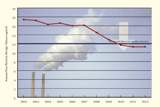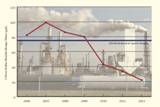|
Click on photo to view larger image




|
The amount of soot in the air continues to go down. Mercury emissions from the largest power plants dropped by more than three quarters. The number of bad air days in comparison to hot weather days that can increase air pollution continues to decrease.
MDE’s review of preliminary monitoring results from 2012 shows that the quality of air across Maryland continues to show measurable signs of improvement.
The continued improvements come after actions taken in Maryland to reduce air pollution, including the Healthy Air Act, the toughest power plant emission law on the east coast. Because pollution from neighboring states contributes significantly to Maryland’s air pollution, Maryland is taking steps to address this issue. Other measures that could lead to continued improvements in air quality include a proposal to lower vehicle emissions and lower the sulfur content of gasoline and a stricter national standard for mercury emissions from new power plants.
“Maryland has been a leader in national efforts to improve air quality for nearly 40 years, and these preliminary monitoring results for 2012 show we are continuing to make progress,” said MDE Secretary Robert M. Summers. “But our research shows that states upwind of Maryland are responsible for about 70 percent of Maryland’s air quality problem. Addressing air pollutants from neighboring states is a priority for Maryland.”
Reducing air pollution improves public health, and actions that reduce pollution can also help restore the Chesapeake Bay. Some programs reduce air pollution by increasing fuel efficiency, which also helps to reduce the greenhouse gas emissions that contribute to climate change.
Trending in the right direction
Ozone and fine particles are Maryland’s biggest air quality issues. Both pollutants are created from fuel-burning sources such as vehicles, electric utilities and industrial boilers. These pollutants can irritate the respiratory system causing coughing, throat irritation and chest pains. They are also linked to premature death.
MDE reviewed preliminary monitoring results from 2012. The results – which are viewed in relation to health-based standards for air quality as established by the U.S. Environmental Protection Agency – show:
- Decreases in fine particle, or soot, pollution in counties across Maryland. All of these measurements -- from all monitoring stations in counties across Maryland -- meet federal standards, including recently strengthened annual standards. Maryland was among a group of states that took successful legal action to require the U.S. Environmental Protection Agency (EPA) to issue a new, strengthened annual air standard for fine particle, or soot, pollution to better protect public health.
- Continued declines in sulfur dioxide pollution. Levels for the State were less than a quarter of those recorded in 2008. In March, EPA proposed “Tier 3” emission and vehicle fuel standards that include lower levels of sulfur in gasoline, which would further reduce sulfur dioxide pollution. Sulfur dioxide is the most significant contributor to the problem of fine particles.
- Monitoring stations in Garrett and Washington Counties and Baltimore City recorded ozone levels that met health standards. In the summer of 2012, the temperature topped 90 degrees on 46 days at Baltimore-Washington International Thurgood Marshall Airport, and the health standard for ground-level ozone was exceeded on 29 days in Maryland. In comparison, in 1995 the temperature topped 90 degrees on 51 days -- and the ozone standard was exceeded on 71 days. Nitrogen oxide, which is emitted when fossil fuels are burned, combines with volatile organic compounds to form ground-level ozone when cooked by the sun. But the ratio of bad air days to temperature has declined over the years in Maryland.
- Concentrations of some airborne toxic chemicals, emitted primarily from mobile sources, such as benzene, toluene and 1,3-butadiene, measured at monitoring stations in the Baltimore metropolitan area in 2012 are less than half of levels measured in 2000. The amount of hazardous air pollutants released from Maryland electrical power plants has been reduced by 89 percent since the implementation of the Maryland Healthy Air Act in 2009.
Emissions reductions from the Maryland Healthy Air Act are occurring in two phases. The first phase, which occurred in the 2009-2010 timeframe, reduced emissions of nitrogen oxides by almost 70 percent and sulfur dioxide and mercury emissions by 80 percent. Those requirements are being met. In the second phase, which is occurring in the 2010-2013 timeframe, nitrogen oxides emissions will be reduced by about 75 percent, sulfur dioxide emissions will be reduced by 85 percent and 90 percent of mercury emissions will be controlled. To accomplish these reductions, Maryland utilities have invested approximately $2.6 billion in pollution controls to meet the requirements of the Healthy Air Act.
The transport issue
With Maryland’s implementation of the Healthy Air Act, the Clean Cars Program, the Regional Greenhouse Gas Initiative, energy conservation and renewable energy goals, the scientific evidence shows that Maryland has effective controls in place to address the air pollution generated in-State. However, the science also demonstrates clearly that Maryland cannot fully meet air quality standards that protect public health unless air pollution generated outside of our State’s borders is controlled. Research indicates that states upwind of Maryland are responsible for as much as 70 percent of Maryland’s current air quality problem. Reducing emissions in upwind states is the key to solving our air quality problems.
What you can do
“Breathing clean air is something most of us take for granted. But if you have respiratory concerns such as asthma, poor air quality is something that can’t be ignored,” MDE Secretary Summers said “We all make choices everyday that can help reduce air pollution.”
There are many ways to help, including:
- Conserve energy by turning off lights and appliances when you leave a room.
- Use energy-efficient appliances such as refrigerators, air conditioners, heat pumps and furnaces.
- Reduce, Reuse, Recycle – this also conserves energy and reduces emissions.
- When possible, walk, bike or use public transportation to get around town.
- Avoid letting your car idle – this will reduce toxins and other pollutants from being released into the air.
- Get regular engine tune ups and car maintenance checkups.
- Carpool or use public transit to get to work.
- Shop with reusable bags instead of using paper or plastic.
- Plant trees in locations around your home to provide shade in the summer.
- Follow air quality forecasts and plan your outdoor activity as appropriate. Put off mowing the lawn or painting and reduce driving on bad air days.
|
